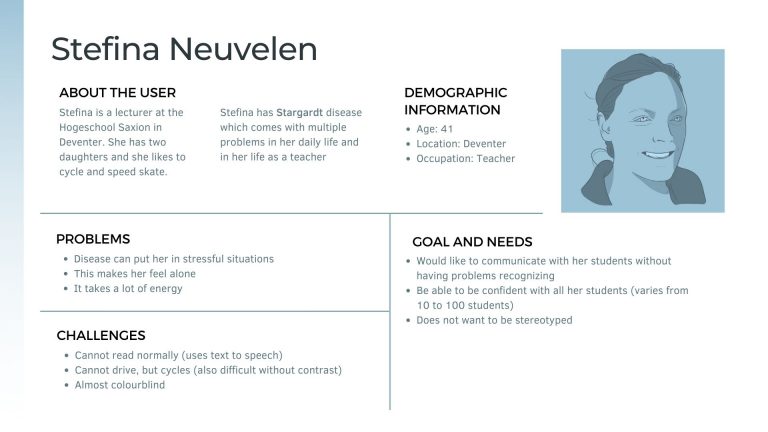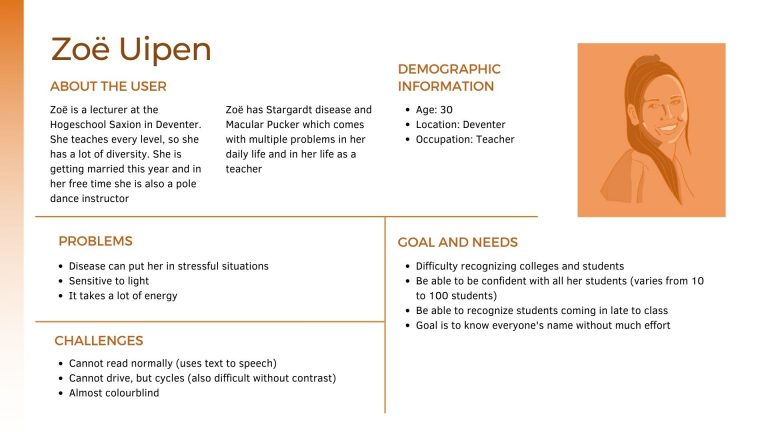Context
In order to work best with our case owners, a context mapping study was conducted. This section presents its results, including the disease and the situation of the case owners leading to personas and a first draft of our design challenge.
The Study
Many people with disabilities need assistance to cope with their challenges and increase their capabilities. Co-design involves the user in the design process to increase customer satisfaction and loyalty. It provides a better understanding of user needs and validates ideas, resulting in a product that fits the user’s situation and creates greater satisfaction. This context mapping discusses various aspects of co-design and the case of people with Stargardt’s disease. Context mapping is used to inspire and contribute to a suitable concept based on the daily lives of case owners. Our two case owners are described and their struggle to recognize people is the center of the study.
Our Case Owners
A problem that people with Stargardt disease face is, among other things, face recognition. We as a group worked together with two case owners. They are both teachers at the University of Applied Sciences Saxion in Deventer, and both suffer from Stargardt disease. In addition, one of the case owners also suffers from Macular Pucker which affects her eyesight even more. The case owners feel they have trouble with forming a personal connection with their students, since they cannot recognize them.
Before our first meeting, we asked the case owners to send us a journal of their daily life in order to get to know them better and set up the interview guide accordingly (to find an optimal design challenge). They were set on the problem they wanted help with, therefore they sent us a specific scenario instead, where the problem occurs.
Here, you can find the interview guide for our first case owner’s meeting that we prepared after receiving the scenario. The case owners signed the consent form during that meeting.


The Design Challenge 1.0
Developing a method or a product that can help the case owners connect with their students in a more personal way while it does not draw attention to the case owners’ disabilities.
Involving people with disabilities in the design process is crucial to designing effective products for people with disabilities. Societal trends related to changing perceptions of disability can influence the design of assistive technology. Gwernan-Jones (2008) states Disability segregation stems from the medical model, while the social model promotes inclusion. We need to hear the voices of people with disabilities for better products and empowerment. Assistive technology allows them to take control of their lives and participate in activities that represent the general public.
Assistive technologies are devices or software that help people with disabilities perform challenging or impossible tasks. Examples include: mobility aids, communication devices, task-specific software, etc.
The following theories and concepts can help design successful assistive technologies:
– Universal Design creates flexible products that adapt to individual needs.
– Person-Centered Design puts the user at the center of the design process.
– Human-Computer Interaction studies how people interact with digital technologies to design effective interfaces.
– Cognitive Load Theory maximizes ease of use and minimizes cognitive demands.
– Accessibility designs products that are easy to use and understand for people with a wide range of abilities and disabilities.
Stargardt disease assistive technologies
Stargardt disease is an inherited eye disorder that causes progressive vision loss. Assistive technologies that may be helpful for someone with Stargardt disease include: magnifiers, screen readers, voice recognition software, color filters, orientation and mobility aids, Etc.
The success of the design of assistive technologies means involving the user and considering their needs, preferences, and abilities.
Technology abandonment (TA)
Assistive technologies often get abandoned due to various reasons like:
– improper fit
– technological advancements
– not meeting user needs
For example, 78% of hearing aids are abandoned. TAs are typically designed to help users complete tasks rather than efficiently complete them. As the severity of the user’s condition changes, the user’s needs may change, resulting in abandonment. Products must be designed to adapt to these changes and remain relevant.
Technology appropriation
Assistive technologies should be tailored to the specific needs of the end user. For example, a cane designed for people with mobility problems should be able to adjust to their height. If the product does not meet the user’s needs, the user adapts it to their daily life. This is called technological appropriation. For Stargardt patients, technology should be easy to use, appropriate, and seamlessly fit into their daily lives without adding burden. Visually demanding technologies can be tiring with regular use and should be avoided.
Human Centered Design (HCD) focuses on people and their needs, motivations, emotions, behaviors and perspectives. Research and prototype testing must be done to ensure the final product meets user requirements, increasing satisfaction and adoption. HCD also leads to more innovative solutions and considers the impact of design on communities and the environment. HCD requires designers to demonstrate empathy, care, and ensure accessibility for all users while working with stakeholders to find the best solutions.
- fine detail
- color blindness
- sensitivity to bright light
Research is underway to find a solution for Stargardt disease, including a new drug called LBS-008, which is in phase three trials. LBS-008 is intended to slow or stop the progression of the disease by preventing toxins from accumulating in the eye. Another product on the market that may help people with Stargardt disease is OrCam MyEye, a voice-activated device that attaches to glasses and can read text, recognize faces, shop, and more.
Co-design involves working with multiple stakeholders, including designers, users, and other parties, to achieve a design that meets everyone’s needs. This process emphasizes communication, co-creation, and iteration, and is especially useful when developing complex solutions involving multiple perspectives. By engaging end-users and stakeholders, co-design can lead to more inclusive and effective solutions, build trust and engagement with stakeholders and increase implementation success.
Examples of Co-Design methods can be found in the full paper, downloadable at the end of the paper.

